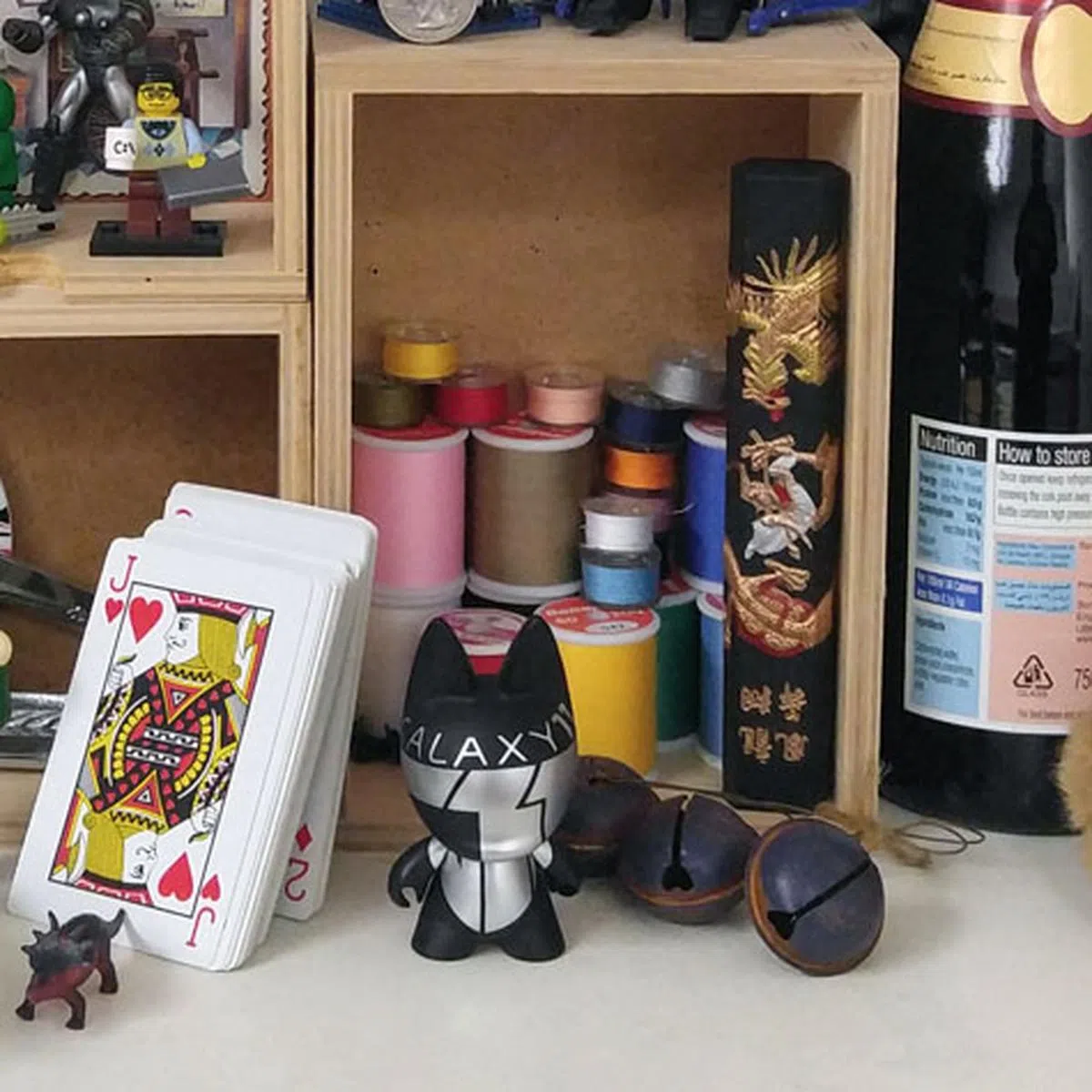LG V10 smartphone review: And now for something completely different
The LG V10 is a pretty big departure from LG’s previous flagship, the G4. It isn’t curved, it isn’t plastic and it doesn’t have a leather back. What it does have is two selfie cameras, two front displays, and a textured, rubberized rear cover that feels like the grip of a power tool. Not to forget are its removable battery and expandable storage. Is this the best LG phone ever?
By HardwareZone Team -
Overview
The LG V10 is a pretty big departure from LG’s previous flagship, the G4. It isn’t curved, it isn’t plastic and it doesn’t have a leather back. What it does have is two selfie cameras, two displays (a small always-on secondary screen sits above the main 5.7-inch display) and a textured, rubberized rear cover that feels like the grip of a power tool.
Design
LG has finally ditched the all-plastic builds and gone for a really nice stainless steel frame with the V10. Two colors are available locally, a dark blue with silver sides, and a beige option with gold sides. We really like the stainless steel, which makes the V10 feel rugged and rigid in a way that its aluminum rivals just can’t match - there’ll be no #bendgate here.

Surprisingly, despite its stainless steel construction and large size, the V10 only weighs 192g, exactly the same as the iPhone 6s Plus. As with LG’s previous flagships, all of the buttons on the V10 are positioned at the rear of the phone with two volume keys framing one circular power button, all nestled centrally underneath the camera module. For the first time on an LG phone, the circular button also doubles up as a fingerprint scanner. The fingerprint scanner works reasonably well, but it isn’t quite as fast or accurate as the sensor on the other phones in our shootout. The V10 requires you to press down on the power button to wake it and then a second or so for the phone to unlock.
The rear of the phone has a rubberized finish with a heavily textured diamond pattern that has an industrial sort of feel to it - it reminds us of the grip you might find on a power tool. Obviously, it’s not as pretty as the leather on the back of the G4 but it provides a very reassuring grip, which is most welcome on a phone this size.

The back cover on the V10 is removable. Underneath you'll find both a microSD card slot and a removable battery, making it one of the last flagship smartphones to offer both and are highly wanted by enthusiasts and professional consumers alike. The microSD card slot is particularly noteworthy as it supports cards up to a massive 2TB. This is in addition to the 64GB storage of internal storage that comes as standard.

The micro-USB port and headphone jack can be found on the bottom of the phone, next to a single speaker unit:-

For even more photos and close-up of the phone, check out our First Looks article here!
Display
The main display on the V10 is a 5.7-inch IPS LCD with a QHD 2,560 x 1,440 (515ppi) pixels resolution. The display is ultra sharp and very bright, but colors look a bit muted and blacks, while deep, are naturally not as good as some of the AMOLED displays out there.

Above the main display there’s an always-on 2.1-inch secondary display. This little window displays notifications and other system status messages. It’s not quite as useful as I first thought it would be, but it does show the time and some notification icons when the main display is off, which is quite nice. There’s even an option to display your name or any other custom message here in a faux-signature style, just for a tiny touch of personalization.


Features
The V10 runs on Android Lollipop 5.1.1 and comes with all the usual LG extras you've come to love, like KnockOn, which lets you tap twice on the screen to wake it up, and KnockCode, which lets you unlock the device with a unique tapping gesture. LG's Smart Bulletin app dedicates an entire home screen page to a variety of widgets, including the music player, your Calendar, the LG Health fitness tracker and more.

There's also a useful Dual Window option, which for some reason is buried in the Settings menu, that lets you split your screen in two so you can use two apps simultaneously.

Snap Video and Quick Video Editor
To take advantage of the V10's rear camera LG has added some extra features dedicated to taking and editing videos. The Snap Video tool lets you stitch together short video clips into a 60-second movie. Here's a video from LG demonstrating it:-

If you shoot a lot of footage while you're out and about, you can use the V10's Quick Video Editor to edit videos on the go. This feature lets you trim your video and add recorded sound or background music, as well as one of four color filters. They're great for quickly posting content to social media, but you might want to export or use a dedicated third-party app for more serious work.

When you do want to share your masterpiece online, the Quick Share tool is a helpful feature that lets you easily share your video to social media or send it in an email.
High-resolution Audio
The LG V10 comes with a built-in Sabre 9018 DAC, and Sabre 9602 Headphone Amplifier to provide high resolution audio. The Sabre DAC delivers industry leading dynamic range of up to 127dB and THD+N (total harmonic distortion plus noise) of 120dB. The ESS audiophile technology integrated into the LG V10 allows supports most popular high resolution and lossless audio formats including FLAC, ALAC, AIFF and WAV.
Benchmark Performance
Like the LG G4, the V10 is powered by a Qualcomm Snapdragon 808 hexa-core processor (quad-core 1.44GHz & dual-core 1.82GHz). On paper this makes it slightly slower than smartphones running on Qualcomm's flagship 810 processor, but it does have 4GB RAM, an upgrade from the 3GB that the G4 runs on.
Here's how the V10 stacks up against the rest of 2015's flagship smartphones:
Sunspider Javascript
SunSpider JavaScript measures the browsing performance of a device when processing JavaScript. It not only takes into consideration the underlying hardware performance, but also assesses how optimized a particular platform is at delivering a high-speed web browsing experience. Unfortunately the V10 came out last among the top flagship phones.

Quadrant
Quadrant is an Android benchmark that evaluates a device's CPU, memory, I/O and 3D graphics performances. As this is an Android benchmark, the Apple iPhone 6s Plus is not included here. The V10 again lagged behind on this benchmark, however the difference between it and the 810-equipped devices wasn't as large. However, Samsung's Exynos 7420-equipped Note 5 was way ahead of the pack.

3D Mark 2013
3DMark 2013 - Ice Storm is designed to test the gaming capabilities of a device, putting its GPU through a rigorous OpenGL ES 2.0 benchmark test that uses fixed off-screen rendering with high quality textures and post-processing effects. The Unlimited version of the benchmark disables v-sync, display scaling and other OS factors, making it ideal for chipset comparison.
Unfortunately, the V10 once again trailed in this benchmark.
On all three benchmarks, comparing the V10 to the LG G4, the extra 1GB of RAM didn't make much difference, with both phones posting almost identical scores.

Camera Performance
The camera module on the back of the V10 is the same 16-megapixel shooter with optical image stabilization and laser autofocus as the G4. The G4’s camera was already one of the best around, and for the V10 it’s been improved with a number of software upgrades. Automatic mode has been finely tuned to nail the correct focus, exposure, ISO and shutter speed each time, while the improved manual mode gives expert photographers even more granular control over white balance, focus, ISO and shutter speed.
One thing to note is that the V10’s Manual mode is fully manual, which means you can’t set Auto ISO in Manual, so when you change shutter speed, you’ll also need to shift ISO to compensate, and vice versa. Even in advanced DSLR cameras’ Manual modes, you still have the option to set Auto ISO while controlling shutter speed and aperture.

Manual mode on the LG V10
Those manual controls are also available when you’re shooting video now, and you can also set your frame rate along with resolution, right from the app. There’s also new video stabilization software, which works in tandem with the phone’s optical image stabilization, resulting in some very clean hand-held video. When shooting video you also have access to advanced audio controls - you can adjust the volume, enable Wind Noise Filter and adjust the directivity. This means you can tune the LG V10's microphones to capture mainly your narration or focus them at the scene.

Manual mode when shooting video.
Overall image quality on the V10 is excellent, with lots of detail and natural, if slightly muted colors. However, the camera doesn't do as well in low light situations as there tends to be quite a lot of noise.

Click for full-size image.
 |  |
For an in-depth review of the LG V10's rear camera, and to see how it fared against the rest of 2015's flagship smartphones, check out our shootout: The best camera smartphone of 2015.
On the front of the phone, you get two selfie cameras: one with an 80-degree field of view, and one designed for group selfies (wefies?) with a wider 120-degree field of view. You can change between them by tapping the onscreen icons (one showing an individual, and one showing a group). Both cameras use 5-megapixel image sensors.

80-degree selfie camera.

120-degree wefie camera.
Battery Life
Our standard battery test for mobile phones involves:
- Looping a 800 x 480-pixel video with screen brightness and volume at 100%
- Wi-Fi and Bluetooth connectivity turned on, and constant data streaming through email and Twitter
Due to its massive high resolution main display and always-on secondary display, the V10 didn't fare too well in our battery life test, lasting just seven hours and ten minutes, less than half that of the Galaxy Note 5.

Conclusion

The V10 is an interesting phone. It's a big departure from LG's flagship G-series, and its release just a few months before the G5 debuts at MWC later this month, makes us pretty sure that LG made it just to experiment with other designs and materials, something we applaud them for.
The V10 isn't cheap either. At S$1,088, it costs S$160 more than the ceramic version of the G4, and it's definitely not for everybody, although we can see it appealing to some who will be drawn to its unique features. The stainless steel frame makes it feel like a tank, and the rubberized rear with its power tool-style grip gives it a rugged feel. It's also one of the last smartphones with a removable battery and a microSD card to support up to 2TB of expandable storage. Ultimately though, it's let down by underwhelming benchmark performance and a short battery life (mitigated somewhat by its removable battery).
Our articles may contain affiliate links. If you buy through these links, we may earn a small commission.